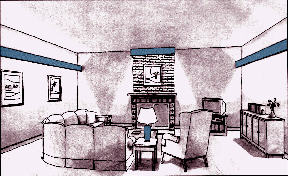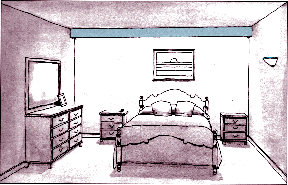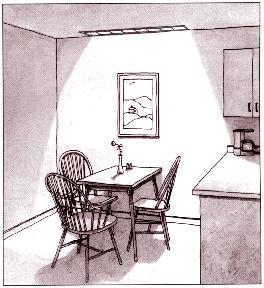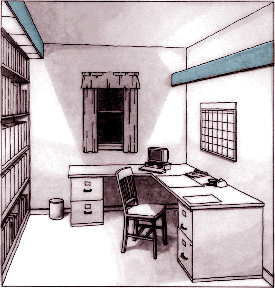Architectural Luminaires
Architectural luminaires are built-in lighting systems. A simple architectural luminaire houses one or more inexpensive linear fluorescent lamps. The luminaire mounts to the ceiling or wall; a shielding board conceals the lamps.- Cove, soffit, and valance architectural luminaires flatter living rooms, bedrooms, kitchens, and bathrooms with white or light-colored walls and ceilings. Soffits and valances in kitchens and bathrooms can provide lighting on countertops.
- Two rows of linear fluorescent lamps, either T8 (1-inch diameter) or T12 (1-1/2-inch diameter), provide enough light even for deep rooms requiring high light levels. Individual switching of each row allows the home owner to have separate high and low light settings.
- Two types of ballasts can be used for the fluorescent lamps, either a magnetic ballast or an electronic ballast. The electronic ballast has no hum, no perceptible flicker, is lightweight, and has lower power losses. It operates the lamps more efficiently but is more costly than a magnetic ballast.



Living room with architectural luminaires. The side walls have valances; the fireplace has a soffit.
- Shielding boards can be made from 1-inch lumber stock, plywood, metal, or drywall. The interior of the shielding board and other surfaces concealed from view should be painted with semigloss white paint for reflectance and ease of cleaning.
- Shielding boards can be finished with stain, paint, wallpaper borders, or fabric, making the architectural luminaire both inexpensive to build and attractive.
- There are a variety of ways to secure architectural luminaires. Fastening a luminaire for linear fluorescent lamps directly to the ceiling or wall reduces the weight on the shielding board, which can be attached to perpendicular walls using angles, hinges, or wood blocking. For longer shields or when luminaires are attached to the shielding board, metal brackets or wood blocking screwed or lag bolted to the rear wall support the additional weight.
- Build the luminaires so that lamps can be replaced without removing the shielding board.
- CAUTION - Architectural luminaires wash walls and ceilings, highlighting finish imperfections such as taping and sanding irregularities.
Soffits
Architectural luminaires that direct light downward are called soffits. Soffits wash walls and provide general lighting in rooms with low ceilings. Soffits can be used for direct lighting over a counter or a table in many work areas.
Recessed soffits can be installed between joists that run parallel to the wall.

|

|
| Bedroom with soffit luminaire. |
Valances
Valances (architectural luminaires that direct light both upward and downward) provide general lighting and wall-washing. The top of a valance can be aligned with the tops of windows and doors.
|
|
| Home office with architectural luminaires. A valance luminaire is over the desk; a soffit luminaire washes the bookshelf. |
Coves
Coves are architectural luminaires that direct light upward. Coves fit well in rooms with high or vaulted ceilings and above kitchen cabinets. For best results the top of a cove should be at least 18 inches from the ceiling and its base at least 6 feet 8 inches from the floor. In kitchens, install the cove right atop the cabinet, although the clearance often will be only 12 inches.
 
|

|
| Kitchen with cove luminaire above the cabinets with a valance luminaire over the sink and under-cabinet lighting. |
Baffles, Louvers, and Diffusers
Architectural luminaires can often be left open above and below the shielding board. Baffles, louvers, and diffusers can eliminate most direct views of the lamps from normal viewing positions and landings overlooking the room. Baffles are parallel blades that come in different sizes, finishes, and blade heights, and spacings. One-inch-high white blades separated by a 1-inch space are usually appropriate. Baffles are manufactured 6 inches to 10 inches wide and 4 feet long.

|
|
| Dinette with baffled recessed troffer luminaire containing linear fluorescent lamps. |
Louvers, or egg crates, usually have cell sizes of 1/2-inch x1/2-inch x1/2-inch and are cut to fit from a 2 foot x4 foot sheet by the contractor. Polystyrene yellows, so acrylic and painted metal make better louvers. Louvers are finished in white, silver, and g.
Diffusers completely eliminate all views of the lamp, but they reduce the light output from the luminaires more than louvers and baffles do. Builders cut diffusers from acrylic, K-12 prismatic lenses. Diffusers work best when installed prism-side out or when made of a matte-finish, acrylic opal.
When you purchase a luminaire, look for the "ENERGY STAR" label.
| Next Section |





